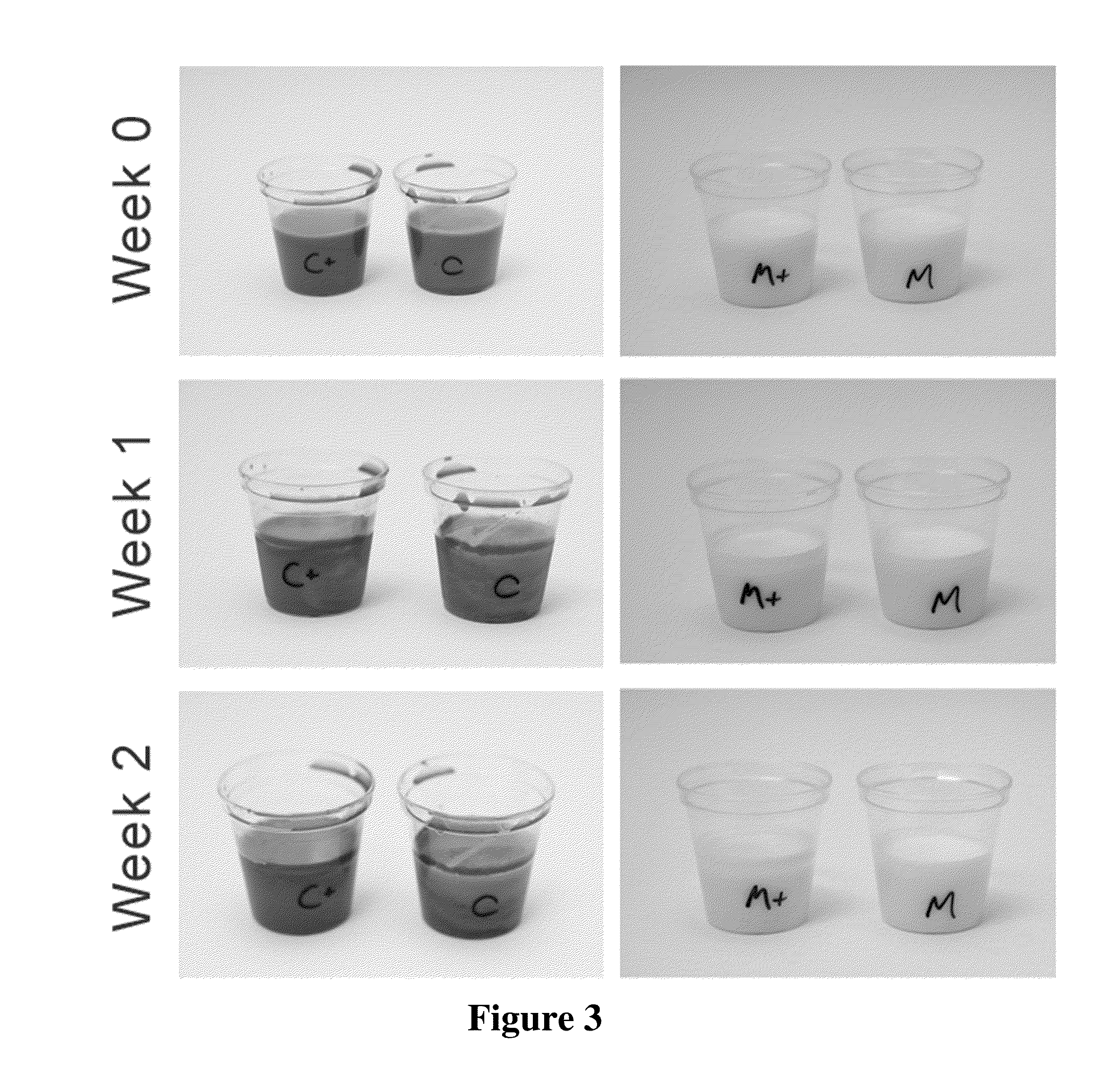Non-Synthetic Emulsion-Based Lipid Formulations and Methods of Use
a technology of synthetic emulsifiers and lipid formulations, applied in the field of non-synthetic emulsifier-based lipid formulations and methods of use, can solve the problems of insufficient research and development, significant technological gaps that have not been explored nor answered, and synthetic emulsifiers that can be antagonistic or interfere with the activity/function of nutrients,
- Summary
- Abstract
- Description
- Claims
- Application Information
AI Technical Summary
Benefits of technology
Problems solved by technology
Method used
Image
Examples
embodiments
[0051]In one embodiment, there is a lipid solution and an aqueous solution. In another embodiment, the lipid solution is more than 10% and the aqueous solution is less than 90%. In another embodiment, the lipid solution is more than 25% and the aqueous solution is less than 75%. In one embodiment, the lipid solution is more than 50% and the aqueous solution is less than 50%.
[0052]In one embodiment, a co-solvent is added to the lipid solution. In another embodiment, a co-solvent is added to the lipid solution to reduce the viscosity of a liquid nutrient ingredient. In another embodiment, the co-solvent is a natural product. In another embodiment, the amount of the natural product co-solvent is a minimum to produce particle sizes of 50 nm-600 nm. In another embodiment, the amount of the natural product co-solvent is a minimum to produce particle sizes of 100 nm-400 nm. In another embodiment, the amount of the natural product co-solvent is a minimum to produce particle sizes of 100 nm-...
example 1
[0161]Two separate solutions were made, a 10% lipid solution and a 90% aqueous solution. In the lipid solution, 5 g of vitamin E (70% tocotrienol from annatto seed) was added to 5 g of a co-solvent (limonene oil) to make the 10 g lipid solution. In the aqueous solution, 3.6 g of a natural tree-bark surfactant (quillaja saponins) was dissolved in pH 7.0 buffered water to make up 90 g of aqueous solution. These two solutions were first blended, and then put three times through a high-pressure homogenizer. A milky yellow emulsion was formed. The ratio of Surfactant to Solution was 1 to 28. Limonene was used to minimize viscosity. Zeta potential was measured using a light-scattering electrophoretic mobility instrument (Malvern Instruments).
[0162]The size of the nanoparticle and the stability of the emulsion were:
[0163]Particle Size: 115 nm
[0164]Zeta Potential: −64 mV
[0165]Tocotrienol (w / w): 3.5%
[0166]Visual Suspension: no creaming, no precipitation
example 2
[0167]Tocotrienol (vitamin E from annatto) was used as the bioactive component. The tocotrienol was extracted from the solution, before and after emulsion homogenization, and were measured by HPLC to test the stability of composition. Acceptable losses were observed through the emulsion process.
[0168]The results were as follows:
A] Concentrations of tocotrienol and limonene oil were 0.95 and 0.84 g / ml, respectively.
B] 5 g tocotrienol from annatto seed (5.26 ml)+5 g limonene oil (5.95 ml)=10 g (11.2 ml)
C] Tocotrienol (v / v) is (5.26 / 11.2)×7% [concentration of tocotrienol in the nanoemulsion]=3.29%
D] HPLC tocotrienol analysis=3.0%
E] % Recovery / Yield is (3.0 / 3.29)×100=91.2% (loss of <9%)
[0169]High-pressure homogenization causes severe agitation of the lipid and aqueous phases that may introduce air (˜20% oxygen) into the solution; which may oxidize a bioactive ingredient in the solution. This potential oxidation may cause unwanted degradation or reduce the bioactive ingredient.
[0170]This...
PUM
| Property | Measurement | Unit |
|---|---|---|
| diameter | aaaaa | aaaaa |
| diameter | aaaaa | aaaaa |
| zeta potential | aaaaa | aaaaa |
Abstract
Description
Claims
Application Information
 Login to View More
Login to View More - R&D
- Intellectual Property
- Life Sciences
- Materials
- Tech Scout
- Unparalleled Data Quality
- Higher Quality Content
- 60% Fewer Hallucinations
Browse by: Latest US Patents, China's latest patents, Technical Efficacy Thesaurus, Application Domain, Technology Topic, Popular Technical Reports.
© 2025 PatSnap. All rights reserved.Legal|Privacy policy|Modern Slavery Act Transparency Statement|Sitemap|About US| Contact US: help@patsnap.com



